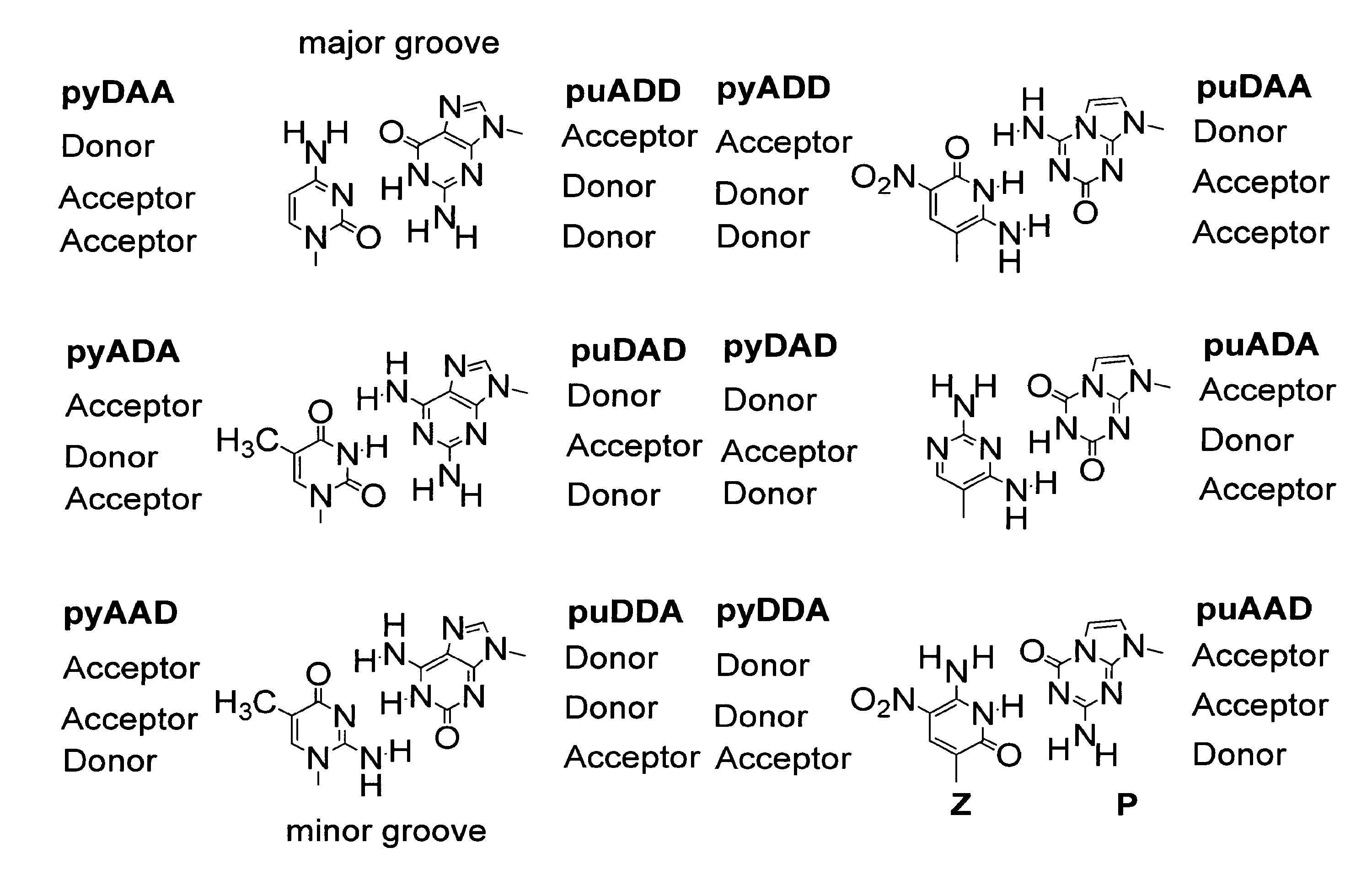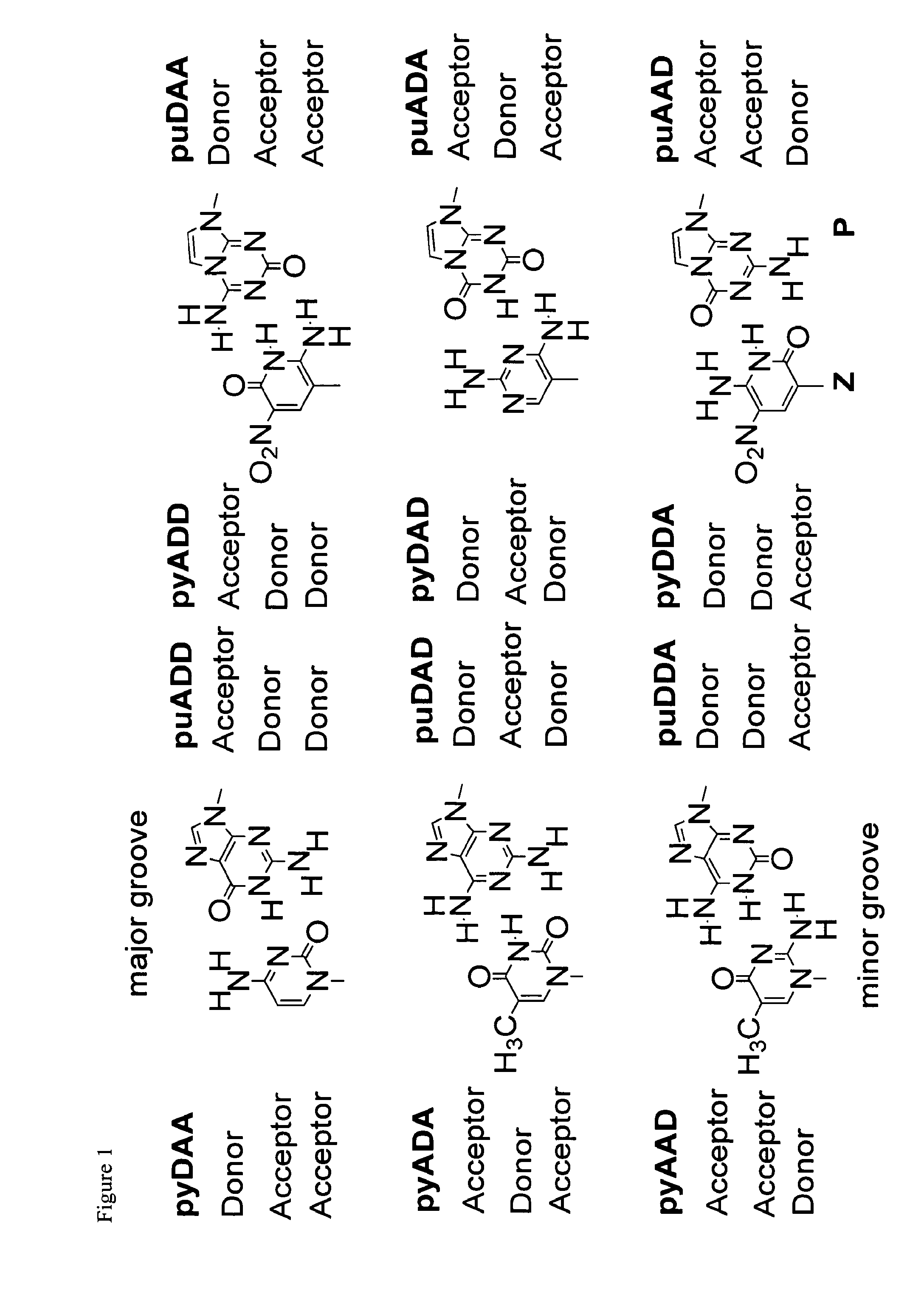Polymerase incorporation of non-standard nucleotides
a technology of polymerase and non-standard nucleotides, which is applied in the direction of microbiological testing/measurement, biochemistry apparatus and processes, fermentation, etc., can solve the problems of epimerization [voe96a,b], oxidation [von95], and uncharacterized decomposition
- Summary
- Abstract
- Description
- Claims
- Application Information
AI Technical Summary
Benefits of technology
Problems solved by technology
Method used
Image
Examples
example 1
PCR with dZ and dP
[0032]This example demonstrates that chimeric primers containing dZ and dP in their external segments support PCR. The following oligonucleotides were prepared by phosphoramidite synthesis. These include two reverse chimeric primers, identical except that in R-36-Nest, some of the G's were replaced by P's in the segment not complementary to the template:
[0033]
R-36-Std:SEQ ID 13′-CCATGGTAGCTATGCGCAACGCTAGCGAGGAAGGAC-5′-P32R-36-Nest:SEQ ID 23′-CCATGGTAGCTATGCGCAACPCTAPCGAPGAAPGAC-5′-P32
a pair of complementary template sequences:
[0034]
Temp-R-47:SEQ ID 35′-CCATGGGAGACCGCGGTGGGCCCGGCCGGGTACCATCGATACGCGTT-3′Temp-F-47:SEQ ID 43′-GGTACCCTCTGGCGCCACCCGGGCCGGCCCATGGTAGCTATGCGCAA-5′
and two forward chimeric primers, one with the same replacements:
[0035]
(F-34-Nest)5′-CTAPGACPACGPACTPCCCATGGGAGACCGCGGT-3′SEQ ID 5(F-34-Std)5′-CTAGGACGACGGACTGCCCATGGGAGACCGCGGT-3′SEQ ID 6
[0036]The underlined portions of the primers are complementary to the template. The portions not underlined are...
example 2
Nested PCR
[0039]This experiment demonstrated the use of dZ and dP pairing in the external segments of a nested PCR [Bro97], shown schematically in FIG. 2. The following oligonucleotides were prepared by phosphoramidite synthesis. These were set up in three set of nested PCR experiments. The first used external primers, one containing dP, the other not:
[0040]
F-17-Nest32P-5′-CTAPGACPACGPACTPC-3′SEQ ID 7F-17-Std32P-5′-CTAGGACGACGGACTGC-3′SEQ ID 8
applied in a direct PCR experiment for a longer template that included Temp-R-47 in its middle:
[0041]
Temp-R-81:SEQ ID 95′-CTAGGACGACGGACTGCCCATGGGAGACCGCGGTGGGCCCGGCCGGGTACCATCGATACGCGTTGCGATCGCTCCTTCCTG-3′
and two reverse external primers, one containing dP, the other not:
[0042]
R-17-Std:3′-CGCTAGCGAGGAAGGAC-5′SEQ ID 9R-17-Nest:3′-CPCTAPCGAPGAAPGAC-5′SEQ ID 10
[0043]These were incubated using the following procedure in Experiment A.
[0044]
VolumeFinalComponents(μl)ConcentrationNuclease-Free Water7.65(final volume of 20 μl)Forward Primer: F-17-Std o...
example 3
Primer Extension Through Adjacent dZs in a Template
[0049]Given the well-known idiosyncrasies of polymerases and the possibility of strong neighbor effects [Hor95], it was not clear that these results would be extendable to PCR amplifications where dZ or dP are adjacent in a template, requiring the incorporation of dP and dZ adjacent in the template. The following experiments were done to screen thermophilic polymerases for their ability to incorporate dPTP opposite dZ in the template. This was done at the following concentrations: [dATP]=[dCTP]=[dTTP]=100 microM), dGTP (5 microM to 100 microM), or dPTP (5 microM to 100 microM) at pH7.0 or 7.5, with the following oligonucleotides (R-19-S was P-32 labeled at its 5′-end):
[0050]
R-19-S:SEQ ID 115′-GGTACCATCGATACGCGTT-3′R-36-Nest-6Z:SEQ ID 123′-CCATGGTAGCTATGCGCAAGTZZTTZZTCGZTAGZG-5′
[0051]5′-32P-labeled primer R-19-S (2 pmole, final assay concentration 50 nM) was annealed to a template sequence R-36-Nest-6Z (3 pmole, final assay concentra...
PUM
| Property | Measurement | Unit |
|---|---|---|
| temperature | aaaaa | aaaaa |
| Tm | aaaaa | aaaaa |
| temperatures | aaaaa | aaaaa |
Abstract
Description
Claims
Application Information
 Login to View More
Login to View More - R&D
- Intellectual Property
- Life Sciences
- Materials
- Tech Scout
- Unparalleled Data Quality
- Higher Quality Content
- 60% Fewer Hallucinations
Browse by: Latest US Patents, China's latest patents, Technical Efficacy Thesaurus, Application Domain, Technology Topic, Popular Technical Reports.
© 2025 PatSnap. All rights reserved.Legal|Privacy policy|Modern Slavery Act Transparency Statement|Sitemap|About US| Contact US: help@patsnap.com



